Kenda I Hanno1*, Ahmed M Abdelhamid2, Mohamed Moataz Khamis2
1Lecturer of Prosthodontics, Faculty of Dentistry, Alexandria University, Alexandria, Egypt
2Professor of Prosthodontics, Faculty of Dentistry, Alexandria University, Alexandria, Egypt
*Corresponding Author: Kenda I Hanno, Lecturer of Prosthodontics, Faculty of Dentistry, Alexandria University, Alexandria, Egypt; Email: [email protected]
Published Date: 08-07-2022
Copyright© 2022 by Hanno KI, et al. All rights reserved. This is an open access article distributed under the terms of the Creative Commons Attribution License, which permits unrestricted use, distribution, and reproduction in any medium, provided the original author and source are credited.
Abstract
Background: The purpose of this case report is to describe a case of full arch rehabilitation in the maxilla and mandible using fixed detachable BioHPP frameworks veneered with prefabricated veneers in the presence of one-piece implants.
Methods and findings: A 63-year-old male patient presented with a maxillary acrylic resin fixed restoration supported on six implants and a mandibular implant retained overdenture on two one-piece implants. Five implants were placed in the mandible in addition to the existing two one-piece implants using CAD/CAM surgical guides. Steps for prosthetic construction of the final full arch BioHPP restorations were completed. The mandibular BioHPP framework was relieved during construction to accommodate the one-piece implants. Cement was applied to fill the space in the framework above the one-piece implants.
Conclusion: Full arch screw-retained restorations can be fabricated in the presence of one-piece implants without sectioning of the abutment part to avoid patient discomfort and heat generation. The low modulus of elasticity of BioHPP along with prefabricated PMMA veneers provided a major advantage over other materials by dampening the occlusal forces and reducing debonding rates.
Keywords
Screw-Retained; Full Arch; Prefabricated Veneers; PEEK; Abutment
Introduction
Full mouth rehabilitation, has become a popular restorative option in dental settings. Implant-supported fixed restoration is a well-established treatment method for edentulous patients [1]. Full-arch implant restorations are preferred to be screw-retained, to allow retrievability without damaging the restoration or fixture [2]. It is possible to adjust the prosthodontic components, refasten the screws, and repair the fractured components with less time and at lower cost than with cement-retained restorations [3,4].
Several materials have been used for the construction of the frameworks for implant supported fixed dental prostheses. Metal frameworks possess good mechanical properties, and and can be easily corrected in case of ill-fitting frameworks [5]. However, the high elasticity modulus of metal-ceramic restorations is the main reason for loosening of the screws and cracks in porcelain. In addition, warpage of the metal occurs during porcelain firing, resulting in poor fit and requires soldering procedures after ceramic application [6].
Zirconia has been used to overcome the disadvantages of metal. Zirconia frameworks are biocompatible, and possess good mechanical properties [7]. However, the disadvantage of zirconia frameworks is that they are difficult to repair in case of ill-fitting frameworks, and remake of the framework is required. Layering of porcelain is used to cover the zirconia frameworks. Despite the esthetic advantage, high rates of fractures or chipping have occurred [8].
Biocompatible High Performance Polymer (BioHPP) (Bredent, Germany) is a modified Polyether Ether Ketone (PEEK) -based polymer with 20% fine ceramic fillers which is the basis for the extremely good polishing properties, low plaque accumulation and reduction in the degree of discolouration since the surfaces are polished to a high shine [9]. BioHPP provides excellent biocompatibility and good mechanical properties [10,11]. Its modulus of elasticity is approximately 4 GPa, presenting an elastic behavior comparable with bone allowing for flexure and torsion of the jaw [12,13]. There are a limited number of studies evaluating the properties of this material, and reports are generally in-vitro [14,15]. The bond strength between BioHPP and Polymethylmethacrylate (PMMA) or indirect composite resin materials is high [16-18]. In addition, BioHPP is radiolucent, which makes detection of loosening of the screws easier by inspection of a periapical radiograph. Another important property of BioHPP is low specific weight allows lighter prostheses to be constructed. This is the main reason patients with BioHPP restorations are highly satisfied and more comfortable during function.
There is a scarcity of reports in the literature discussing solutions and suitable materials for construction of a fixed detachable full arch restoration in the presence of two one-piece implants without having to section the abutment portion. The aim of this article is to describe a case of full arch rehabilitation in the maxilla and mandible using BioHPP frameworks in the presence of two one-piece implants in the mandible.
Methods
The technique has been approved by the Ethical Committee of the Faculty of Dentistry, Alexandria University. The ethical approval international number is IORG0008839. The Ethical committee number is 0141-07/2020. The patient involved in the case report signed an informed consent form before participation.
A 63-year-old male presented for replacement of the mandibular overdenture with an implant supported fixed restoration. The patient had a maxillary acrylic resin restoration supported on six implants (five SwissPlus and one TSV, Zimmer dental, USA) and a mandibular implant overdenture retained by two one-piece implants (Fig. 1).
Regarding the medical history of the patient, he did not suffer from any systemic disease. Planning for implant placement was completed using Cone Beam Computed Tomography (CBCT). A CAD/CAM surgical guide was used for placement of six implants (Superline, Dentium, Korea) in the mandible in addition to the existing one-piece implants.
A complete denture was fabricated prior to implant placement and used as a temporary fixed detachable denture immediately after implant placement by using plastic temporary abutments (Fig. 2). After three months, the maxillary acrylic resin restoration was removed and the screw abutments were inserted in the mandible using torque wrench. Impressions and custom trays were completed. The maxillary abutments were splinted using autopolymerising resin (Opti-Cold; Bredent, Senden, Germany) on the cast, then sectioned. They were inserted in the patient’s mouth and splinted intraorally using DuraLay resin.
For the mandibular arch, open tray impression copings were positioned on the cast and splinted, sectioned, and inserted in the patient’s mouth. They were splinted intraorally using DuraLay resin. Definitive maxillary and mandibular impressions were made using vinyl polysiloxane impression material (Express VPS; 3M ESPE, USA). The definitive casts were poured using Type IV dental stone (Exakto-Rock S, Bredent, Senden, Germany) and silicon gingival mask (Multisil-Mask soft, Bredent, Senden, Germany). Verification indices were fabricated on the casts and inserted intraorally for implant position verification.
Acrylic resin rims and bite registration material (Occlufast, Extra hard Shore A; Zhermack, USA) were used to obtain a record of the centric relation (Fig. 3). Prefabricated anterior PMMA composite veneers (Novo.lign; Bredent, Senden, Germany) were arranged, and evaluated intraorally for both esthetics and phonetics (Fig.4). This was followed by arrangement of posterior veneers (Fig.5). A laboratory silicone index (Haptosil, Bredent, Senden, Germany) was used for recording the teeth positions on the cast. The framework was relieved to accommodate the one-piece implants and then constructed from BioHPP (Fig.6). The technique of construction used was the lost wax technique using a special investment (Brevest, Bredent, Senden, Germany) and heating to a temperature of 650-850ºC. Vacuum press device (2 press; Bredent, Senden, Germany) designed for this material is used at a temperature of 400ºC and a pressure of 550 kPa.
The silicone matrix was used to obtain the original recorded teeth arrangement. The BioHPP framework and veneers were airborne-particle abraded with 110-µm aluminum oxide, coated using a composite resin primer (Visio.link, Bredent, Senden, Germany) and polymerized by light curing for 90 seconds. A composite resin that has the color of dentin (Combolign, Bredent, Senden, Germany) was used for attachment of the composite veneers to the BioHPP framework. A pink nanofilled composite resin (Crea.lign, Bredent, Senden, Germany) was used for the soft tissues (Fig. 7,8).
During insertion of the final restorations, the relieved area in the framework above the one-piece implants was filled with glass ionomer luting cement (Ketac Cem radiopaque, 3M ESPE, USA), to seal any gaps to prevent the leakage of saliva between the one-piece implants and the framework. The undercut caused by the one-piece implants is small and it will not interfere with retrievability of the restoration when needed.
Occlusion was adjusted and the full arch restorations were tightened to 30 Ncm (Fig. 9,10). Polytetrafluoroethylene (PTFE) was used to block the screw access holes followed by light cure composite resin (Spectrum; Dentsply Sirona, York, PA).
Follow up of the patient was accomplished after delivery of the restorations by two weeks, three and six months. The patient had no complaints.

Figure 1: Preoperative panoramic radiograph.
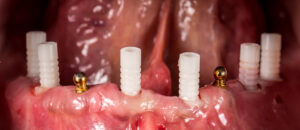
Figure 2: Plastic temporary abutments used for temporary fixed detachable denture.
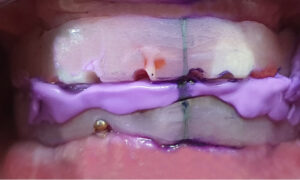
Figure 3: Centric relation record.

Figure 4: Anterior teeth try in.

Figure 5: Arrangement of posterior veneers.
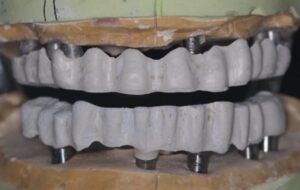
Figure 6: BioHPP frameworks.
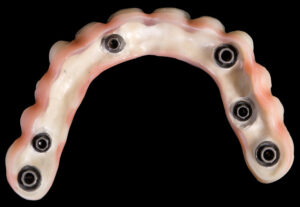
Figure 7: Fitting surface of the maxillary BioHPP full arch restoration.
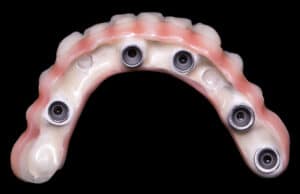
Figure 8: Fitting surface of the maxillary BioHPP full arch restoration showing relief over the two one-piece implants.
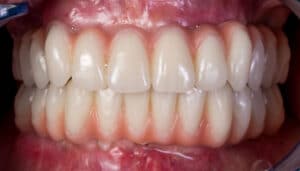
Figure 9: Definitive screw-retained implant-supported BioHPP full arch restorations.
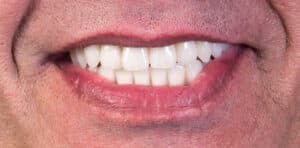
Figure 10: Final intraoral view of maxillary and mandibular full arch restorations.
Discussion
BioHPP has been used to provide a cushioning effect on occlusal forces to the restoration and eliminate complications such as fracture of the veneers or clicking sounds that occur with metal-ceramic or zirconia restorations [19].
The gray colour of the metal frameworks was avoided by the use of BioHPP as a material for framework construction combined with the PMMA veneers which improves esthetics. An important property of BioHPP is low reactivity and lack of water solubility and low making it a more suitable for who are uncomfortable to metallic taste or suffer from allergy to mrtals [20].
To improve the bond between BioHPP and PMMA or composite, the surface should be properly cleaned and roughened. To increase resistance to shear forces, an opaque material is applied. Successful bonding on BioHPP surfaces is provided by surface activation with roughening. The use of PMMA veneers with high impact strength and composite resin of uniform thickness along with a bonding agent has reduced the problem of veneer chipping or fracture to a great degree [21].
Conclusion
BioHPP has been used for several applications in dentistry including implant restorations because of its modulus of elasticity which is similar to that of bone.
Full arch screw-retained restorations can be fabricated in the presence of one-piece implants. The use of prefabricated PMMA veneers combined with elasticity modulus (4 GPa) of BioHPP has acted as a shock absorber to dampen the occlusal forces and reduce debonding.
Long-term clinical evidence is required to demonstrate the use of BioHPP as a substitute for conventional metal-ceramic implant-supported full arch fixed dental prostheses.
Acknowledgements
I would like to express my gratitude to Mr. Walid Diri at Maestro Dental Lab in Cairo, Egypt for the excellent laboratory work. I would also like to express my deepest gratitude to Dr. Ibrahim Hisham Hanno (Pedodontist) and Dr. Mervat Ghoneim (Prosthodontist) for their support and supplying the materials required to complete the work.
Conflict of Interest
There are no conflicts of interest.
References
- Peñarrocha-Diago MA, Maestre-Ferrín L, Demarchi CL, Peñarrocha-Oltra D, Peñarrocha-Diago M. Immediate versus nonimmediate placement of implants for full-arch fixed restorations: a preliminary study. J Oral Maxillofac Surg. 2011;69(1):154-9.
- Michalakis KX, Hirayama H, Garefis PD. Cement-retained versus screw-retained implant restorations: a critical review. Int J Oral Maxillofac Implants. 2003;18:1-5.
- Guichet DL, Caputo AA, Choi H, Sorensen JA. Passivity of fit and marginal opening in screw- or cement-retained implant fixed partial denture designs. Int J Oral Maxillofac Implants. 2000;15:239-46.
- Uludag B, Celik G. Fabrication of a cement- and screw-retained multiunit implant restoration. J Oral Implantol. 2006;32:248-50.
- Silva TB, De Arruda Nobilo MA, Pessanha Henriques GE, Mesquita MF, Guimaraes MB. Influence of laser welding an electroerosion on passive fit of implant supported prosthesis. Stomatologija. 2008;10:96-100.
- Rosenstiel SF, Land MF, Fujimoto J. Contemporary fixed prosthodontics. 5th St. Louis, Mo: Mosby/Elsevier. 2016.
- Fabbri G, Sorrentino R, Brennan M, Cerutti A. A novel approach to implant screw-retained restorations: adhesive combination between zirconia frameworks and monolithic lithium disilicate. Int J Esthet Dent. 2014;9:490-505.
- Daou EE. The zirconia ceramic: strengths and weaknesses. Open Dent J. 2014;8:33-42.
- Rzanny A, Gobel F, Fachet M. BioHPP summary of results for material tests. Research Report. Jena, Germany: University of Jena, Department of Materials and Technology. 2013.
- Seferis JC. Polyetheretherketone (PEEK): Processing-structure and properties studies for a matrix in high performance composites. Polymer Composites. 1986;7:158-69.
- Katzer A, Marquardt H, Westendorf J, Wening JV, von Foerster G. Polyetheretherketoneecytotoxicity and mutagenicity in-vitro. Biomaterials. 2002;23:1749-59.
- Wang H, Xu M, Zhang W, Kwok DT, Jiang J, Wu Z, et al. Mechanical and biological characteristics of diamond-like carbon coated polyaryl-ether-etherketone. Biomaterials. 2010;31:8181-7.
- Hanhel S, Wieser A, Lang R, Rosentritt M. Biofilm formation on the surface of modern implant abutment materials. Clin Oral Implants Res. 2015;26:1297-301.
- Koutouzis T, Richardson J, Lundgren T. Comparative soft and hard tissue responses to titanium and polymer healing abutments. J Oral Implantol. 2011;37:174-82.
- Santing HJ, Meijer HJ, Raghoebar GM, Ozcan M. Fracture strength and failure mode of maxillary implant-supported provisional single crowns: a comparison of composite resin crowns fabricated directly over PEEK abutments and solid titanium abutments. Clin Implant Dent Relat Res. 2012;14:882-9.
- Fuhrmann G, Steiner M, Freitag-Wolf S, Kern M. Resin bonding to three types of polyaryletherketones (PAEKs)-durability and influence of surface conditioning. Dent Mater. 2014;30:357-63.
- Kern M, Lehmann F. Influence of surface conditioning on bonding to polyetheretherketone (PEEK). Dent Mater. 2012;28:1280-3.
- Keul C, Liebermann A, Schmidlin PR, Roos M, Sener B, Stawarczyk B. Influence of PEEK surface modification on surface properties and bond strength to veneering resin composites. J Adhes Dent. 2014;16:383-92.
- Cabello-Domínguez G, Pérez-López J, Veiga-López B, González D, Revilla-León M. Maxillary zirconia and mandibular composite resin-lithium disilicate–modified PEEK fixed implant-supported restorations for a completely edentulous patient with an atrophic maxilla and mandible: A clinical report. J Prosthet Dent. 2020;124(4):403-10.
- Zoidis P, Papathanasiou I. Modified PEEK resin-bonded fixed dental prosthesis as an interim restoration after implant placement. J Prosthetic Dentistry. 2016;116(5):637-41.
- Stawarczyk B, Jordan P, Schmidlin PR, Roos M, Eichberger M, Gernet W, et al. PEEK surface treatment effects on tensile bond strength to veneering resins. J Prosthet Dent. 2014;112:1278-88.
Article Type
Case Report
Publication History
Received Date: 15-06-2022
Accepted Date: 29-06-2022
Published Date: 08-07-2022
Copyright© 2022 by Hanno KI, et al. All rights reserved. This is an open access article distributed under the terms of the Creative Commons Attribution License, which permits unrestricted use, distribution, and reproduction in any medium, provided the original author and source are credited.
Citation: Hanno KI, et al. Full Mouth Implant Rehabilitation Using Fixed Detachable Bio-HPP Frameworks in the Presence of One-piece Implants: A Clinical Report. J Dental Health Oral Res. 2022;3(2):1-10.

Figure 1: Preoperative panoramic radiograph.

Figure 2: Plastic temporary abutments used for temporary fixed detachable denture.

Figure 3: Centric relation record.

Figure 4: Anterior teeth try in.

Figure 5: Arrangement of posterior veneers.

Figure 6: BioHPP frameworks.

Figure 7: Fitting surface of the maxillary BioHPP full arch restoration.

Figure 8: Fitting surface of the maxillary BioHPP full arch restoration showing relief over the two one-piece implants.

Figure 9: Definitive screw-retained implant-supported BioHPP full arch restorations.

Figure 10: Final intraoral view of maxillary and mandibular full arch restorations.


